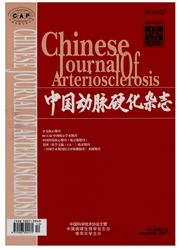

 中文摘要:
中文摘要:
目的观察过氧化体增殖物激活型受体γ信号转导通路在内脂素调控人THP-1单核细胞源性巨噬细胞酰基辅酶A∶胆固醇酰基转移酶1表达中的作用,探讨内脂素诱导泡沫细胞形成的机制和途径。方法 THP-1单核细胞诱导分化为巨噬细胞,随机分组,给予不同浓度的内脂素和过氧化体增殖物激活型受体γ激动剂罗格列酮进行干预,分别运用油红O染色法观察细胞内脂滴形成情况,逆转录聚合酶链反应法和免疫印迹法检测细胞过氧化体增殖物激活型受体γ和酰基辅酶A∶胆固醇酰基转移酶1mRNA和蛋白的表达,酶荧光学法检测细胞内总胆固醇和游离胆固醇含量,总胆固醇与游离胆固醇之差为胆固醇酯含量。结果与对照组比较,内脂素组细胞内脂滴形成增加,过氧化体增殖物激活型受体γmRNA和蛋白表达水平降低(P〈0.05),酰基辅酶A∶胆固醇酰基转移酶1mRNA和蛋白表达水平升高(P〈0.05),细胞内胆固醇酯含量升高(P〈0.05);随着内脂素浓度(10^-7mol/L、10^-6mol/L和10^-5mol/L)升高,过氧化体增殖物激活型受体γmRNA和蛋白表达水平逐渐降低(r值分别为-0.73和-0.83,P〈0.05),酰基辅酶A∶胆固醇酰基转移酶1mRNA和蛋白表达水平逐渐升高(r值分别为0.91和0.72,P〈0.05)。与内脂素组比较,罗格列酮组酰基辅酶A∶胆固醇酰基转移酶1mRNA和蛋白表达水平降低(P〈0.05),细胞内胆固醇酯含量降低(P〈0.05);随着罗格列酮浓度(10μmol/L、15μmol/L和20μmol/L)升高,酰基辅酶A∶胆固醇酰基转移酶1mRNA和蛋白表达水平逐渐降低(r值分别为-0.69和-0.84,P〈0.05)。结论内脂素呈浓度依赖性下调THP-1单核细胞源性巨噬细胞过氧化体增殖物激活型受体γ的表达,上调酰基辅酶A∶胆固醇酰基转移酶1的表达,而罗格列酮呈浓度依赖性抑制内脂素所诱导的上述效应。提示内脂素可能通过过氧化体增殖物激活型受体γ信号
 英文摘要:
英文摘要:
Aim To investigate the role of peroxisome proliferator-activated receptor-γ(PPARγ)signal transduction pathway in the up-regulation of the expressions of acyl-CoA:cholesterol acyltransferase 1(ACAT1)and discuss the mechanism of macrophages-derived form cell formation induced by visfatin.Methods THP-1 monocytes were induced into macrophages by 160 nmol/L phorbol myristate acetate(PMA)for 48 h,then exposed to visfatin and PPARγ activator rosiglitazone.The lipid droplet contents were observed by Oil red staining.The expressions of PPARγ and ACAT1 mRNA and protein were determined by reverse transcriptase-polymerase chain reaction(RT-PCR)and Western blotting respectively.The contents of total cholesterol(TC)and free cholesterol(FC)were detected by enzyme fluorescence analysis.Results Compared with the control group,the lipid droplet contents were increased,the expressions of PPARγ mRNA and protein were down-regulated,the expressions of ACAT1 mRNA and protein were up-regulated,and the contents of cholesterol ester(CE)were increased in visfatin groups.Compared with the visfatin group,the expressions of ACAT1 mRNA and protein were down-regulated in rosiglitazone groups.Conclusion The up-regulation of ACAT1 expression was induced by visfatin via PPARγ signal transduction pathway,which induced foam cell formation.
 同期刊论文项目
同期刊论文项目
 同项目期刊论文
同项目期刊论文
 期刊信息
期刊信息
